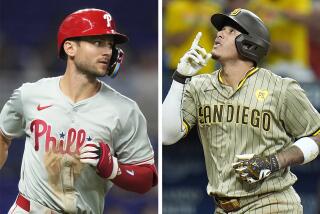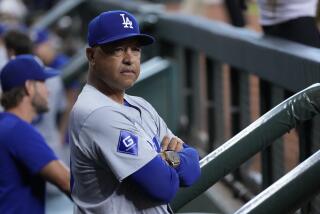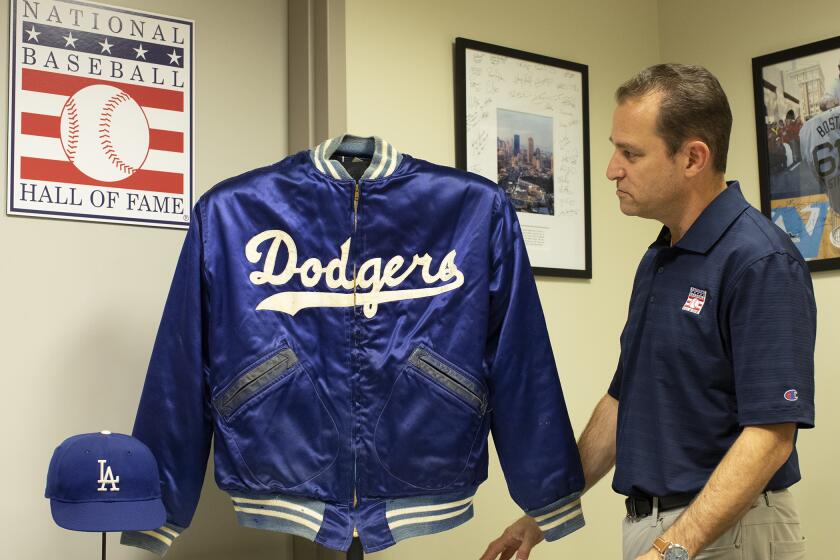What’s next for the Dodgers? Bryce Harper? J.T. Realmuto? A look at the possibilities
- Share via
Recently, a post appeared on Major League Baseball’s Instagram account featuring a photo of Bryce Harper and a question splashed across the bottom: Are the Dodgers the favorites for Bryce?
It’s a possibility the baseball universe is pondering as the winter progresses without an obvious destination for the free-agent outfielder. Then Harper’s account “liked” the post and that universe exploded. Conjectures had already formulated after the Dodgers traded outfielders Yasiel Puig and Matt Kemp as part of a seven-player deal with the Cincinnati Reds that signaled other moves were looming. Harper’s account later “unliked” the post but the double-tap’s power was irreversible. The dots were too easy to connect for social media’s detectives. Harper was signing with the Dodgers, the internet decided.
Harper, of course, hasn’t signed with anyone yet. Neither has Manny Machado, the co-headliner of this free-agent class. The Dodgers reached out to Machado’s camp early in free agency, but the two sides haven’t engaged since, according to a person with knowledge of the situation. Machado will sign elsewhere after recently completing a three-city tour. But the Dodgers remain in contention for Harper.
Before this offseason, the assumption was a team would give Harper a record-breaking 10-year deal. With the Philadelphia Phillies and Chicago White Sox willing to spend lavishly, that remains conceivable. But the line of teams willing to guarantee Harper more than $325 million — the total-value record Giancarlo Stanton set with his 13-year contract — reportedly isn’t long. That has kept the window open for the Dodgers because for Harper to land in Los Angeles, he — and his agent, Scott Boras — would probably have to accept a shorter contract.
The Puig-Kemp trade afforded the Dodgers more financial wiggle room while unclogging some of their outfield glut. The Dodgers saved around $14 million against baseball’s $206-million competitive-balance tax (CBT) line, dropping their projected CBT payroll to approximately $24 million below the threshold, according to Cot’s Baseball Contracts, which isn’t always 100% accurate but is one of the best resources available to the public. But $24 million per season isn’t enough to sign Harper. The Dodgers would either have to surpass $206 million or shave more salary to avoid a tax penalty if they think Harper — a 26-year-old, six-time All-Star and former MVP whose uneven production year to year confounds — is worth the investment. But should the penalty even concern Los Angeles?
By staying below the CBT line last season after paying a tax bill the previous five years, the Dodgers reset their next penalty to 20% on every dollar spent over the threshold up to $20 million. Surpassing the ceiling in consecutive years produces a 30% penalty. Three straight seasons and the tax rate climbs to 50%. Teams that surpass the line by $20 million up to $40 million must also pay a 12% surtax. The penalty grows to 42.5% if they exceed the threshold by more than $40 million and includes having the top pick in the next draft drop 10 spots.
The Dodgers could sign Harper to a contract this winter with an unprecedented average annual value of $40 million that would put them about $15 million over the luxury-tax line for 2019 and in line for a $3-million penalty — less than half the amount they sent to the Reds in last week’s trade — based on their current commitments listed by Cot’s Baseball Contracts.
The Dodgers treasure having the flexibility to acquire veteran contributors during the season, but midseason additions usually don’t significantly increase CBT payrolls. They could then have the penalty reset again when their payroll plummets for the 2020 season. Around $90 million is slated to come off the Dodgers’ CBT payroll next offseason (before the 2020 season), when the threshold jumps to $208 million.
For reference, the Boston Red Sox and the Washington Nationals were the only teams to exceed the CBT line in 2018. The Red Sox, who soared more than $40 million over the threshold, paid approximately $12 million in taxes and had their top pick in June’s draft plunge 10 places. They won the World Series. The Nationals, who have paid the tax the last two seasons, were charged around $1.2 million. They didn’t advance to the playoffs.
Even if Harper and the Dodgers aren’t a match, Los Angeles could add payroll to address other areas, namely upgrading their starting rotation and filling their hole at catcher.
The Cleveland Indians are still reportedly engaged in talks for starters Corey Kluber and Trevor Bauer, but their need to discard salary has lessened after they traded Yonder Alonso, Edwin Encarnacion, and Yan Gomes. Kluber, 32, is owed $17 million next season and has club options for the next two years for a combined $35.5 million. Bauer turns 28 next month and is under team control the next two seasons.
Meanwhile, J.T. Realmuto, to the bewilderment of many in the industry, is still a Miami Marlin. The Marlins’ price for the All-Star catcher remains steep, according to a person with knowledge of the situation, but the Marlins are expected to cash in their final significant trade chip with a couple of years of team control left.
Yasmani Grandal, who turned down the Dodgers’ $17.9-million qualifying offer, remains a free agent after declining a four-year, $60-million offer from the New York Mets, according to a person with knowledge of the situation. But a Los Angeles reunion with the catcher is unlikely unless he is willing to sign a short contract. If Realmuto isn’t an option, the Dodgers, with catching prospects Will Smith and Keibert Ruiz nearing the majors, would prefer a one-year stopgap. Choices in that aisle include the Pittsburgh Pirates’ Francisco Cervelli, who is entering the final year of his contract, and free agent Martin Maldonado.
Then there’s the Dodgers’ sudden dearth of power right-handed bats after offloading Puig and Kemp. As it stands, the Dodgers have six outfielders on their 40-man roster. Two – Enrique Hernandez and Chris Taylor — are right-handed-hitting utility players. The other four — Cody Bellinger, Joc Pederson, Andrew Toles and Alex Verdugo — all hit left-handed. As do Corey Seager and Max Muncy. Justin Turner, David Freese and Austin Barnes are the only other projected contributors who bat right-handed.
If the Dodgers believe they need another right-handed bat, Realmuto would fill the void. They’ve reached out to the Detroit Tigers about outfielder Nick Castellanos, but the initial asking price was Verdugo or Ruiz, according to a person with knowledge of the situation. Los Angeles has also been linked to St. Louis Cardinals first baseman Jose Martinez, who is without a position after the Cardinals acquired first baseman Paul Goldschmidt. Outfielder A.J. Pollock, second baseman D.J. LeMahieu, utilityman Marwin Gonzalez and infielder Jed Lowrie are potent right-handed hitters still available in free agency.
Harper is a left-handed batter, but that is irrelevant for a player of his caliber. He would play every day against pitchers from both sides, and perhaps make Verdugo, a 22-year-old with nothing left to prove in the minors, disposable in a trade to improve in another area. With or without Harper, the Dodgers’ offseason — already bustling with activity — promises to include more moves.
Twitter: @jorgecastillo
More to Read
Are you a true-blue fan?
Get our Dodgers Dugout newsletter for insights, news and much more.
You may occasionally receive promotional content from the Los Angeles Times.











